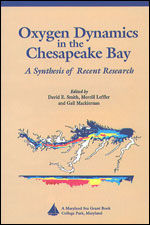|
|
|
Long shallow shoulders run along the edges of the Bay's main channels, the hidden history of sea level rise over the past fifteen centuries. The shallows reach into countless tributaries, where depths may drop to only a few feet or disappear altogether as tidal flats go dry twice a day. Writers have called it skinny water. The Bay is nothing if not skinny.
It is in the shallows where underwater grasses once grew in abundance, where oyster bars flourished.
And yet most of the monitoring that informs our picture of the Bay has tested deeper waters. Tom Malone realized this when he first set his zig-zag course back and forth across the Bay. So did Walter Boynton. Boynton, an ecologist, always had a special interest in the Bay's small coves and backwaters. Working out of the UMCES Chesapeake Biological Laboratory in Solomons Island, he studies nutrient dynamics and the health of sediments. He's found that he can learn a lot about the quality of the water by studying the health of the sediments lying beneath them.
In waters as shallow as those of the Chesapeake, the link between bottom and top is strong. In the shallows, nutrients in the sediment lie close to the surface. This puts nutrients nearer algae as they float beneath the surface, using light for photosynthesis. In shallow water, dying algae don't have far to sink before gathering on the bottom, where they decompose, releasing more nutrients. And with less volume than deeper waters, the shallows tend to concentrate algal blooms. On the other hand, oxygen can reach the shallows more quickly than in deeper water, and, when waters are clear enough, rooted plants can grow in the shallows and still see the sun.
Things can change fast in the shallows.
With all this and more in mind, during the mid-1990s, ten years after the federal-state Chesapeake Bay Program launched its main monitoring effort, Boynton began a rigorous focus on shallow water monitoring. He used emerging technologies that allowed real-time or near real-time testing from small boats. As the boat traveled along, an intake drew water through a hose and ran it into a monitoring machine. They called it a Data Flow device.
"Walter Boynton deserves a lot of credit for starting the shallow water monitoring effort," says fellow UMCES researcher Michael Kemp. "He and Chris Madden."
Christopher Madden, now at the South Florida Water Management District, developed the package of technologies and techniques for shallow water monitoring. Boynton's group then refined the process.
Boynton started making the case for an ongoing, continuous effort to monitor the Bay's shallows. Given the importance of the shallows to the Bay ecosystem, he argued, the lack of data there represented a huge knowledge gap. His proposal presented a daunting challenge to government agencies, given the extent of shallow habitats in the Chesapeake, but the Maryland Department of Natural Resources (DNR) understood the need.
Since 2002, the Maryland DNR has supported a shallow water monitoring system comprised of fixed monthly monitoring sites and continuous monitoring sites. They call it Eyes on the Bay, and it's impressive (see "Eyes on the Bay").
Donald Boesch, the president of UMCES, agrees that it's a remarkable resource. While preparing for a recent radio talk show in Washington, D.C., Boesch wanted a quick update on conditions during the summer of 2007. It struck him immediately how much information we now have, thanks to efforts like Eyes on the Bay. A quick click tracked conditions in the Patuxent, the Choptank, all around the state. "It's a tremendous tool," he says. "And its potential is probably under-used."
Since 2003 the Virginia Institute of Marine Science (VIMS) and the Chesapeake Bay National Estuarine Research Reserve in Virginia have mounted a similar continuous monitoring program, also available on the web (see "For Further Information").
Those early zig-zag cruises by Malone and others provided wonderful "snapshots," Kemp says. They told us a lot about the sloshing of salty bottom waters up on the edges, including waters devoid of oxygen (or, anoxic) that could harm life on the Bay's shallow shoulders. Now we have running tallies of salinity, oxygen, and other details thanks to dozens of shallow monitoring sites around the Bay.
Over the past thirty years, we have come a very long way.
|
A Classic Text
Understanding why the Bay gasps for air in the summer months has proved one of the major breakthroughs in Chesapeake science. In 1985, the Sea Grant Programs of Maryland and Virginia teamed up with the National Oceanic and Atmospheric Administration to launch a five-year research effort focused on oxygen processes in the Chesapeake. The results of this work were captured in the 1992 book, Oxygen Dynamics in the Chesapeake Bay. "This book is a classic," says Daniel Conley of Sweden's Lund University. Conley is now using the book to inform a similar effort underway in the Baltic Sea, which also suffers from too many nutrients. "That book changed the way we look at the Bay," says long-time Bay researcher Larry Harding at the University of Maryland Center for Environmental Science. Before then, he says, we tended to look at the problem in pieces, and for scientists, in experimental terms, project by project. The 1992 book took the wide view, he says, the long view. Many of the processes detailed in this book are now part of the public's broad understanding of how nutrients, algal blooms, and dissolved oxygen interact in the Bay. |
|
|
|

![[Maryland Sea Grant]](/GIFs/h_footer_mdsg.gif)